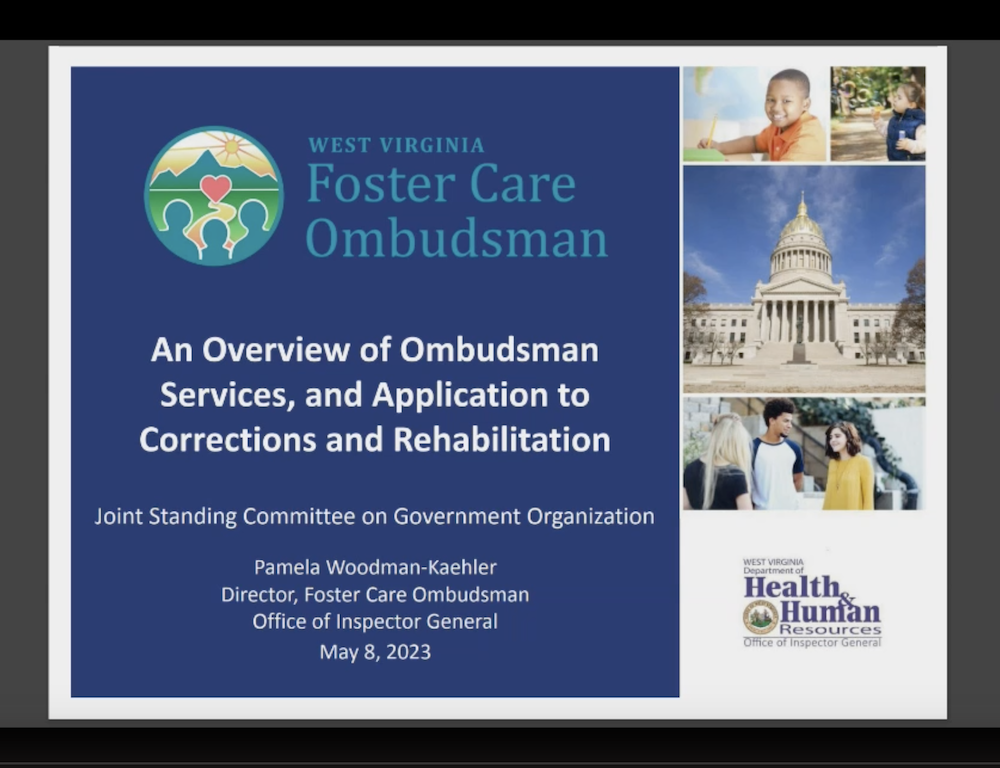By Matt Young, West Virginia Press Association
HUNTINGTON, W.Va. – The West Virginia Legislature’s Joint Standing Committee on Government Organization, on Monday, heard presentations on both the scope of the state’s Foster Care Ombudsman, as well as the grievance procedure for inmates housed within the state’s correctional facilities.
First to present was West Virginia’s current Foster Care Ombudsman, Pamela Woodsman, who began by providing a brief explanation of her duties.
“[The Ombudsman is] an independent, impartial public official with authority and responsibility to receive, investigate, or informally address complaints about government actions,” Woodsman said. “The Ombudsman is a centuries-old role, to serve, protect, and give greater voice to vulnerable people and groups.”

West Virginia’s Foster Care Ombudsman was established with the passage of HB 2010 in 2019 as a mechanism for parents and foster children to “convey issues and receive assistance.” Subsequent legislation in 2020, and 2023, further defined the scope of the Ombudsman’s role.
“As of this morning, the total number of complaints received by the foster care system was 1,834,” Woodsman noted. “We talked to hundreds and thousands of people overall in meetings and in panels. A very important part of what we do is substantiate or validate complaints that are validatable which come to our office. We keep track of complaint validity by topic and by county, and we are working hard to attempt to map that so that, drilled down to a county level, that information can be used constructively by leaders and lawmakers for problem-solving.”
According to Woodsman, among the more commonly received complaints by the Ombudsman are general health and safety concerns, access to physical and mental healthcare, the grievance process, segregation, outside communication, discipline, and assaults.
“Given that we have now collected such a large body of data, we continue to use – what I call – a suped-up spreadsheet to capture everything that we do,” Woodsman added. “Ombudsman have the potential to mitigate organizational risk and loss, and that can be economic or non-economic. We can provide early intervention and early warning. As you know, the earlier you attack a problem, the less costly and the less controversial and the less time consuming it is likely to be.”
At the conclusion of Woodsman’s presentation, Del. Kayla Young, D-Kanawha, sought clarification, saying, “You collect a lot of data, but it sounds like you don’t know what to do with it or how to really process it.”
“Do you have any intentions of hiring any sort of data analyst?” Young asked.
“We expect a request for positions to be posted soon,” Woodsman replied. “Fingers crossed that that all works the way that it should from the procurement standpoint.”
Next before the committee was Commissioner William Marshall and Executive Officer Brad Douglas of the W.Va. Division of Corrections and Rehabilitation. Douglas began by providing committee members with a brief overview of the inmate grievance process.
“There are laws on the books that prevent an inmate from filing a lawsuit unless they’ve exhausted administrative remedies,” Douglas said. “Inmates are educated about the grievance procedure during intake through the (inmate) handbook, and each grievance is logged.”
Douglas noted that there are three grievance levels, explaining, “Level one is the inmate fills out their grievance form and submits it to their unit manager. If [an inmate] gets a response back and doesn’t like what they were told, they can appeal that to the superintendent-level.”
“And then finally, the last level is the inmate can then appeal that decision to the commissioner,” Douglas added. “At the commissioner’s level, we also have a statewide DCR ADA Coordinator that they can confer with. And we also now have a Physician Director, Dr. (Ayne) Amjad – she works with us now and helps us with the medical grievances.”
According to Douglas, there is a separate and much faster process for resolving grievances alleging sexual abuse or imminent danger of violence. For the period between Jan. 2022 and May 2023, Douglas said that a total of 18,292 inmate grievances were filed across all state facilities. Of that number, approximately 2,700 were appealed to the commissioner.
“You can see there are a lot of them (grievances),” Douglas said. “There are about 10,000 inmates incarcerated now at about 36 different facilities, so the volume is high. Fortunately, this process is time-tested and robust. It’s been in court numerous times over the years. As long as we do what we;re supposed to do on our end and follow our policies, things work out the way they need to.”
Once Douglas concluded his remarks, Del. Young again had questions.
“How many grievances did you have alleging or concerning sexual abuse or imminent violence?” Young asked. “Also, how many of those were remedied in favor of the inmate?”
While neither Douglas nor Marshall had the statistics Young requested, they did advise committee members that they would have that information available for the next meeting.
The next meeting of the Joint Standing Committee on Government Organization is scheduled to occur during the Legislature’s August Interim Session.







